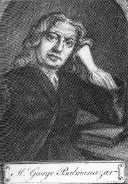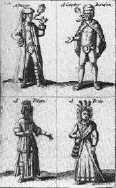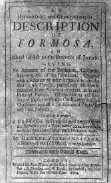The Native of Formosa

George Psalmanazar,
The Native of Formosa
There were just a few problems with the young man's claim of Formosan nationality. First, his skin was white, and his hair was blond. Second, he spoke fluent Latin (which wouldn't be a problem in and of itself), but he did so with a hint of a Dutch accent.
Still, at the beginning of the eighteenth century most of the world remained a mystery to Europeans, and so they had no idea what a real Formosan should look like. They only knew that Formosa was a very distant land where the people undoubtedly had very different customs. And this man certainly had different customs. He occasionally babbled in an unknown language. He worshipped the sun and the moon. He slept upright in a chair with a lamp burning, and he ate heavily spiced raw meat. What better evidence of foreignness could anyone possibly want?

Formosan Fashions, according to Psalmanazar
In 1702 the man from Formosa (he had no other name at that time) arrived in Holland and met a Scottish clergyman called William Innes who was serving in the English army. Innes probably saw through the deception right away, but he also knew a good thing when he saw it. He knew that it would help his career if he could present the church with an exotic convert.
So Innes converted the Formosan to Anglicanism, baptised him with the Christian name George Psalmanazar, and brought him to England to meet the Bishop of London. When the Bishop heard Psalmanazar's strange story of Jesuit intrigue, he embraced him with open arms, as did the rest of British high society. The elite ladies and gentlemen of England treated Psalmanazar as an exotic curiosity. Even the Royal Society took an interest in him.
Of course, Psalmanazar's story did not convince everyone, especially not the Jesuits. The Jesuit Father Fontaney, who was travelling through England at that time, challenged Psalmanazar to a debate which Psalmanazar accepted. But the debate proved inconclusive because Fontaney simply didn't know enough about Formosa to seriously challenge any of Psalmanazar's claims. For instance, when asked why his skin was not darker in color like that of other people from Asia, Psalmanazar replied that in Formosa the members of the nobility lived indoors and therefore had lighter skin than the laborers who worked outside. For all anyone in England knew, this could very well have been true.

Titlepage of Psalmanazar's book
But doubts continued to circulate about Psalmanazar's true identity. These doubts became harder and harder to ignore until finally, in 1706, Psalmanazar confessed to his imposture, supposedly motivated by a religious experience that convinced him of the sinfulness of his deception. He spent the rest of his life working as an editor and a writer on Grub Street. At one point he even contributed a section about Formosa to a work titled Geography of the World, though this article, unlike his previous book, was truthful. Many years later, he wrote a long confession titled Memoirs of ****, Commonly Known by the Name of George Psalmanazar. This work was published posthumously in 1765, a year after his death.

A Floating Formosan Village,
As Depicted in Psalmanazar's Description of Formosa
References/Further Reading:
- Foley, Frederic J. The Great Formosan Impostor. Jesuit Historical Institute. 1968.
- Lynch, Jack. "Orientalism as Performance Art: The Strange Case of George Psalamanazar," talk delivered at the CUNY Seminar on Eighteenth-Century Literature, January 29, 1999.
- Swiderski, Richard M. The False Formosan: George Psalmanazar and the Eighteenth-Century Experiment of Identity. San Francisco: Mellen Research University Press, 1991.
| Main Page | Comments | Search |
Back to Gallery: 1700-1799 |